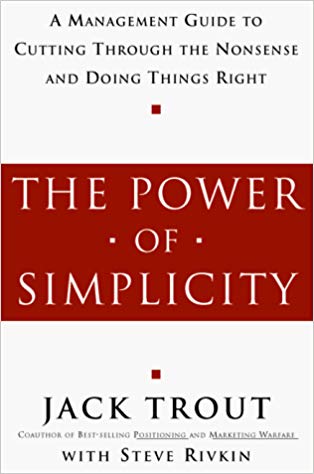The authors of the book The Power of Simplicity believe that business is not very complicated. Many people make it difficult. The main idea of the book – do not invent anything and complicate where you can make everything easier. The authors show how to simplify all areas of business based on examples from practice and interviews with well-known managers.
The book contains 23 short chapters with concise conclusions at the end. The chapters are divided into 5 sections.
The first section. The basics of simplicity
In this section, the authors talk about such things as fear of simplicity, common sense and complex language of communication.
People have a fear of simplicity. They are afraid to look stupid if they choose simple solutions or speak a simple language. The modern language is becoming more complex. This applies to both written and oral speech.
Jack Trout and Steve Rivkin advise encouraging simple, precise language and banning trendy but complex jargon. According to the authors, common sense is an effective antidote to the fear of simplicity. Jack Trout and Steve Rivkin offer the following recommendations to think simply and use common sense:
1. Take your ego out of the situation.
2. Never do wishful thinking.
3. Be sure to learn to listen better.
4. Be a little cynical.
The second section. Management issues
In the second section, the authors pay attention to the following elements: information, consultants, competitors, strategy, customer orientation, annual budgets, and prices.
The complexity of business is compounded by an ever-increasing volume of information. You are not physically able to assimilate everything that you need to know. By limiting the information you receive, you will learn to get more from it.
The authors don’t like consultants. In their view, consultants invent increasingly complex theories, intimidate with complex phrases and clever words, and form unrealistic expectations. They also spend a lot of money on organizing their business training.

Jack Trout and Steve Rivkin advise you to learn how to behave correctly with competitors – you avoid their strengths and play on their weaknesses. They offer four ways to conduct marketing warfare and determine which one will suit you. (Al Ries, Jack Trout “Marketing Warfare”)
Four ways to conduct marketing warfare
1. Defensive warfare is the privilege of leaders. Advanced positions awarded to companies whose customers consider them to be leaders. The company’s objective is market domination.
2. Offensive. The attack strategy fits the second and third numbers. The main principle here is to avoid strong points in positioning the leader. We need to find a weak spot and direct the blow at it. And then focus all your efforts on it. The company’s objective is increased market share.
3. Flanking. Smaller companies or newcomers who are trying to gain a foothold by staying away from the main battles are attacking from the flank. This strategy usually involves moving to an area where there are no competitors and contains an element of surprise. The company’s objective is profitable survival.
4. Guerrilla warfare often becomes the lot of small companies. Its first principle is to find a market small enough to hold it. The company’s objective is survival.
According to Jack Trout and Steve Rivkin, the main thing in strategy is differentiation. To stand out from the others, they describe three stages that need to be completed.
1. Take a simple idea that will set you apart from your competitors.
2. Find a confirmation or product that will make this idea real and make you believe it.
3. Develop a program that allows you to make your current and potential customers aware of the difference.
Many companies know their differences but they consider them too obvious and this makes it difficult to see the situation clearly. Jack Trout and Steve Rivkin advise you to pay attention to customer orientation, but not to give it completely, because this is only the first bid. It allows you to enter the game. But it certainly won’t set you apart from your competitors. The main thing is not to know your customers, but to let them know you.
The authors also suggest an unconventional approach to budgeting that will make the most of the annual portion of the money
Step 1. Prepare marketing plans. In these plans, each product must be located at a certain stage of the life cycle. The plans must be true and based on harsh reality.
Step 2. Arrange the products in the order of prospects. At this stage, you need to consider the indicators – you determine which products will bring more profit if everything is done correctly.
Step 3. Set advertising tasks. Advertising is usually the most expensive part of a marketing plan, so it is important to make sure that the budget allocated for it will bring the maximum benefit and that it will be enough to solve your problems.
Step 4. Stop when you run out of money. Once you’ve prioritized your programs, start with the most important thing and move from top to bottom.
Invest in existing opportunities, not missed opportunities. The authors cite some practical pricing principles that have been tested many times in the market. And most of them are not related to complex mathematics, but to the competition. But their main idea on pricing is that a thing costs as much as buyers are willing to pay for it and how much competitors will allow you to take for it.
The third section. Leadership issues
The third section deals with the company’s mission statements, leadership, long-term planning, organization, marketing, new ideas, goals, and growth.
A mission statement is a relatively new phenomenon in the business world. Today, it is believed that the mission shows what the company wants to be when it grows up. The mission should reflect your main strategy. It should show your idea of differentiation and explain how implementing this idea will help you outperform your competitors. The vague wording of the corporate mission is a sign that the company does not know where it is going.
The strategy, vision, and mission depend on a simple premise: you need to know where you are going. Otherwise, no one will follow you. The best leaders know that today it is not enough to just point the direction. They reinforce a given direction or vision with words and actions.

Jack Trout and Steve Rivkin call long-term planning the art of wishful thinking. A long-term strategic plan is useless if you are aware of your competitors’ plans.
A good organization sets the right strategic behavior. Unfortunately, large firms often become so complex that one part negates the efforts of the other. The authors suggest a horizontal structure in the organization. This approach is good because it is an alternative to an inflexible hierarchical structure.
According to the authors, the essence of marketing is in two sentences. First, the task of marketing is to make sure that everyone plays the same tune in unison. Second, marketing should turn this melody, or differentiating idea, into what the authors call a consistent marketing strategy. An idea defines a strategy. Then the strategy implements the idea. The interaction between the two components is a critical factor for success in marketing.

The easiest way to invent a new product/idea is to apply an existing idea. The authors advise you to save for the future all the clever solutions and strategies that you come across. When you need a solution to a problem, all you have to do is search your archive.
Marketing plans are ruined because of the goals set. The authors are against goals because they detach the marketing process from reality. Another problem with setting a goal is that it is inflexible. Growth is one of the results of doing the right job. Growth should not be a worthy goal. However, in fact, it is the desire for growth that is to blame for the emergence of impossible goals. The authors believe that the company does not make a product or service, but the position it occupies in the minds.
The fourth section. People issues
The fourth section is dedicated to motivation, self-improvement, success, and critics.
Motivation will not ensure a close relationship between employees and the company. First, you should make sure that the path is correct. Real motivation begins with an idea and continues with a challenge made to your employees to bring this idea to life in sales, product development, and technology.
The authors criticize companies that pay a lot of attention to the self-improvement of employees. They provide the following tips to help you deal with issues of self-improvement.
1. Understand what is really happening.
2. Leave self-improvement to individuals.
3. Start with the most basic.
4. Once you understand the basics, develop your professional skills.
5. Remember – this is about learning, not about rest.
If you are focused on yourself, then you only have one bet on success. If you look around and include other people in your field of vision, you will significantly increase your chances. The authors emphasize that success cannot be found within oneself. They recommend looking for the key to success in the outside world.

People admire complexity, although they don’t always understand it. Comments of critics will take different forms, and you should be prepared to defend yourself.
The fifth section. In conclusion
The authors of the book cited in the last chapter many business examples of how the simplification process helps companies achieve success and increase their income. They talk about companies like Papa John’s Pizza, Chick-fil-A, Southwest Airlines, Palm Pilot, Kohl’s Department Stores, The Wine Group, Find/SVP, Charles Industries, Stanislaus Food Products.
This book will be interesting not only for professional marketers but also for general audience because we all tend to complicate life. Any reader will be able to draw a simple conclusion after reading this book: everything complex is an attempt to confuse and lead away from the essence. The professionals also need to return to simplicity and not scare your customers or yourself with unnecessary complications.
In addition to this book I recommend to read Propel Business Beyond Competition by Michael Stelzner.





